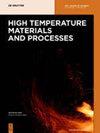天然羔羊革鞣制和激光曝光后的表面形貌
IF 1.5
4区 材料科学
Q4 MATERIALS SCIENCE, MULTIDISCIPLINARY
High Temperature Materials and Processes
Pub Date : 2023-01-01
DOI:10.1615/hightempmatproc.2023046972
引用次数: 0
摘要
本文介绍了单宁鞣制羔羊皮在双脉冲激光照射和随后的铜涂层应用后的形态学研究结果。在激光照射下,观察到真皮的形变和构象变化。展示了利用激光清洗和随后沉积铜涂层以获得装饰性涂层的基于天然皮革的复合材料的可能性。本文章由计算机程序翻译,如有差异,请以英文原文为准。
SURFACE MORPHOLOGY OF NATURAL LAMB LEATHER AFTER TANNIDE TANNING AND LASER EXPOSURE
The article presents the results of a study of the morphology of tannin tanned lamb skin after laser exposure in a two-pulse mode and subsequent application of a copper coating. Under laser exposure, dermis defibration and conformational changes are observed. The possibility of obtaining a composite material based on natural leather with the use of laser cleaning and subsequent deposition of a copper coating in order to obtain decorative coatings is shown.
求助全文
通过发布文献求助,成功后即可免费获取论文全文。
去求助
来源期刊

High Temperature Materials and Processes
工程技术-材料科学:综合
CiteScore
2.50
自引率
0.00%
发文量
42
审稿时长
3.9 months
期刊介绍:
High Temperature Materials and Processes offers an international publication forum for new ideas, insights and results related to high-temperature materials and processes in science and technology. The journal publishes original research papers and short communications addressing topics at the forefront of high-temperature materials research including processing of various materials at high temperatures. Occasionally, reviews of a specific topic are included. The journal also publishes special issues featuring ongoing research programs as well as symposia of high-temperature materials and processes, and other related research activities.
Emphasis is placed on the multi-disciplinary nature of high-temperature materials and processes for various materials in a variety of states. Such a nature of the journal will help readers who wish to become acquainted with related subjects by obtaining information of various aspects of high-temperature materials research. The increasing spread of information on these subjects will also help to shed light on relevant topics of high-temperature materials and processes outside of readers’ own core specialties.
 求助内容:
求助内容: 应助结果提醒方式:
应助结果提醒方式:


